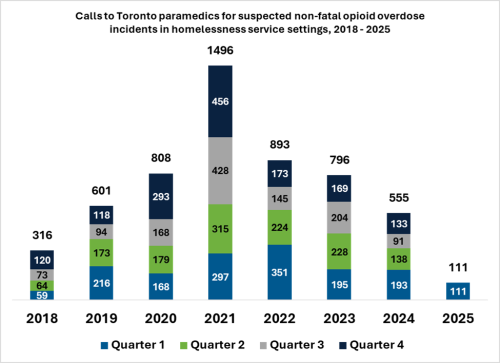Toronto is experiencing a heightened number of non-fatal and fatal opioid overdoses within the overall community, as well as within the shelter system. This is primarily due to the increasing toxicity and unpredictability of the unregulated drug supply.
This page shares data that show the number of fatal and non-fatal suspected opioid overdose incidents in emergency shelters and 24-hour respite sites starting in 2018. Data related to non-fatal incidents are based on Toronto Paramedic Services emergency response data, and data about fatalities related to overdose are provided by the Ontario Office of the Chief Coroner.
This data is updated quarterly. The full dataset can be found on the City’s Open Data site.
For information on city-wide overdose activity, which includes this data specific to homelessness service settings, consult the Toronto Overdose Information System.
Key Points
- There were 111 calls to Toronto Paramedics from Toronto shelters and respites sites in Q1 2025 to respond to non-fatal overdoses, a 17% decrease from Q4 2024 (N=133).
- There were 555 suspected non-fatal overdoses in Toronto shelters over 2024, based on calls to Toronto Paramedics. This is a 30% decrease from 2023.
- The number of non-fatal overdoses increased steadily between 2018 and 2021 and has shown a decrease starting in 2022.
- Non-fatal overdoses increased from an average of 26 per month in 2018, to an average of 67 per month in 2020, and an average of 125 per month in 2021. This decreased to an average of 74 per month in 2022, 66 per month in 2023, 46 per month in 2024 and 37 per month in Q1 2025.
- Non-fatal outcomes are the result of the quick action and response of shelter staff or other residents intervening to save lives by administering naloxone and oxygen and calling for emergency services. The true number of non-fatal overdose incidents is likely even higher than reported here given that paramedics may not be called if those responding on site are able to reverse the overdose and support and monitor the individual.
- Based on preliminary data, there were < 5 suspected drug related deaths of shelter residents in Toronto shelters in Q1 2025.
- In total, there were 27 suspected and confirmed overdose deaths in 2024, representing a 36% decrease from 2023.
- Fatal opioid overdoses among shelter residents increased from an average of less than one per month in 2018 to more than 4 per month in 2020 and nearly 6 per month in 2021. There was an average of more than 5 fatal opioid overdoses per month in 2022, an average of nearly 4 per month in 2023, an average of nearly 2 per month in 2024, and an average of < 5 per month in 2025 (Q1) based on preliminary data.
About the City's Response
In November 2020, to respond to a noted increase in fatal and non-fatal overdoses in the shelter system and the broader community the Toronto Board of Health requested the Medical Officer of Health and City to continue to work with community partners to urgently expand overdose prevention response and other harm reduction measures in shelters.
Since then, the City has taken substantial action to protect those in the shelter system from the risk of overdose, including establishment of the Integrated Prevention and Harm Reduction Initiative (iPHARE) in December 2020 to help advance the Toronto Overdose Action Plan. iPHARE is a multi-pronged effort by the City and community agencies to address opioid-related deaths in Toronto’s shelter system.
The City’s Toronto Shelter Standards outlines requirements for overdose prevention and response strategies that shelter providers must meet, and implementation resources have been developed to support providers.
These actions align with and support the City’s Harm Reduction Framework for City-funded homelessness services.
Non-fatal suspected opioid overdoses in homelessness service settings
Suspected and confirmed opioid overdose deaths in homelessness service settings

*Based on location of primary incident (includes deaths that occurred in hospital)
**Results are considered preliminary and are subject to change. Data is reported up to March 31, 2025. Includes probable and confirmed opioid-related deaths (toxicology positive for opioids) and suspected drug-related deaths. The Office of the Chief Coroner provides data on suspected cases while cases are still being processed. Once the case has been confirmed the status is changed to “confirmed.”
Data Notes & Limitations
- Non-fatal incidents are identified based on the expertise of Toronto Paramedic Services to diagnose an opioid overdose based on physical and incidental information.
- Only incidents where Toronto Paramedic Services are called are captured in the non-fatal suspected opioid overdose incident data set. Other incidents of non-fatal overdose may have been addressed through staff intervention through administering of naloxone.
- Some incidents may be duplicated in the fatal and non-fatal data sets because after Toronto Paramedic Services transports a patient to hospital, further outcomes are not recorded. A patient identified by Toronto Paramedic Services as experiencing a non-fatal, suspected opioid overdose who later dies in hospital will be captured in both fatal and non-fatal data sets.
- The Office of the Chief Coroner and Toronto Paramedic Services have identified cases of fatal overdose based on addresses of locations in the shelter system.
- The data set excludes individuals living in encampments or outside of the formal homelessness services system.


